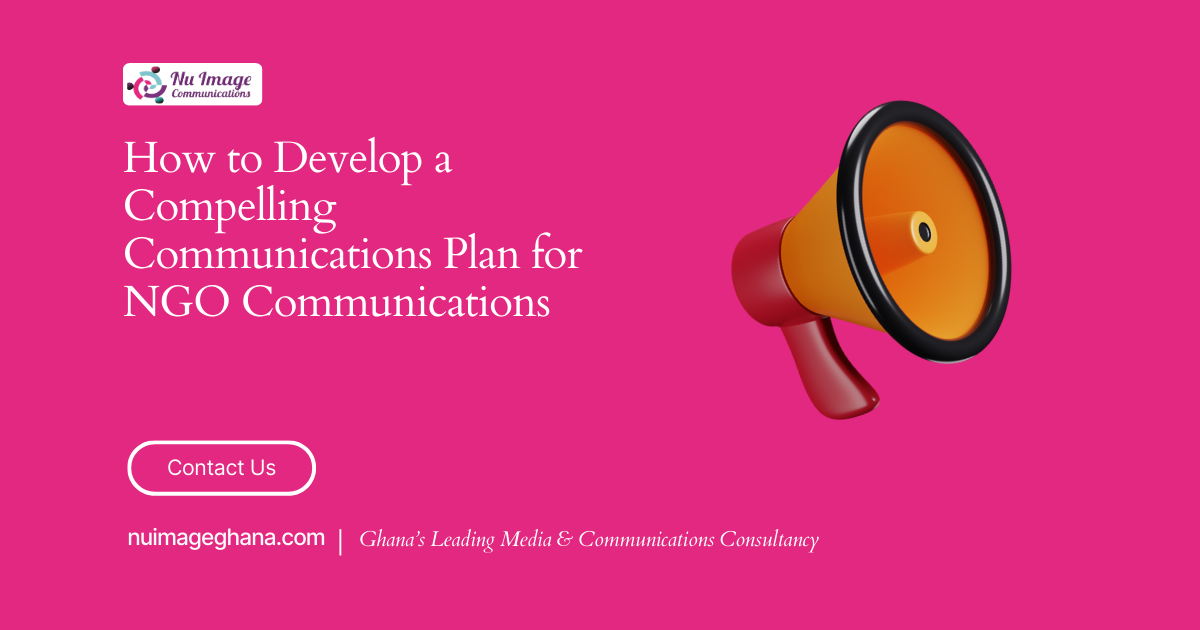
Non-governmental organisations (NGOs) operate in environments where credibility, clarity, and connection with communities are crucial. A communications plan is not just a tool; it is a strategic roadmap that guides how an NGO interacts with its stakeholders, amplifies its mission, and sustains visibility. As Morris Chang wisely said, “Without a strategy, execution is aimless. Without execution, a strategy is useless.” A well-designed communications plan aligns messaging with organisational goals, reduces barriers to engagement, and ensures that communication resonates across diverse cultural and social contexts
1. Foundation: Cultural Awareness and Organisational Readiness
Before diving into tactics, an NGO must understand the cultural and organisational context:
- Cultural awareness: Colours, symbols, and even language carry different meanings across contexts. For example, red signifies luck in China but might carry different connotations in Ghana. Ignoring such nuances can lead to miscommunication or alienation.
- Institutional readiness: An NGO must assess its budget, staff capacity, and leadership support. Without these, even the best-designed plan risks falling apart.
- Credibility check: Conduct an internal SWOT analysis to assess how the organisation is perceived by external audiences. Strong credibility amplifies messages; weak credibility dilutes them.
2. The Four Pillars of an NGO Communications Plan
A. Communicator Strategy: Defining Objectives
At the core of communications planning lies clarity of purpose:
- What does your NGO want to achieve through communications?
- Are you seeking donor funding, community participation, policy influence, or public awareness?
Objectives should be SMART (Specific, Measurable, Achievable, Relevant, and Time-bound). For instance: “Increase youth engagement with our health program by 25% over the next six months through targeted social media campaigns.”
B. Audience Strategy: Knowing Who You Speak To
NGOs often engage with multiple stakeholders each with unique needs:
- Youth under 32 (digital natives requiring visual and interactive content).
- Government officials (need policy briefs and evidence-based data).
- Potential donors (respond to impact stories and transparency).
- Traditional authorities or community leaders (prefer face-to-face meetings or culturally grounded approaches).
Key factors to analyse include demographics, education levels, language, access to technology, and geographic location. Tailoring messages to these realities ensures greater impact.
C. Message Strategy: Crafting the Story
Messages are the lifeblood of NGO communications. They must be:
- Clear and simple – no jargon.
- Focused on needs – identify the problem.
- Linked to solutions – show how the NGO’s work addresses the issue.
- Action-oriented – end with a compelling call-to-action (donate, volunteer, attend, share).
Effective messaging often revolves around three key issues, making it easier for audiences to remember.
D. Channel Strategy: Choosing the Medium
Different audiences require different channels:
- Digital channels: Social media, SMS campaigns, email newsletters.
- Traditional media: Newspapers, radio, community town halls.
- Direct engagement: Workshops, community dialogues, one-on-one meetings with policymakers.
The rule: let the audience guide the channel, not the other way around.
3. Implementation: Turning Strategy into Action
A strong communications plan requires a detailed implementation calendar. • Map out activities by week or month (e.g., media releases, social campaigns, community events).
- Assign responsibilities to team members.
- Allocate budgets for each communication tool (design, printing, digital advertising).
A visual calendar ensures accountability and keeps communication efforts on track.
4. Monitoring and Evaluation (M&E)
An NGO communications plan must not end with execution; it must measure results. Tools include:
- Opinion polls: Simple, low-cost methods to check shifts in awareness.
- Perception surveys: Gauge how stakeholders view the NGO over time.
- Image studies: Compare your NGO’s reputation with peers.
- Communication audits: Assess which tools/channels are working best. These tools allow for course correction, ensuring the plan evolves with realities on the ground.
5. Integration and Sustainability
The final piece is integration. Communications should not be siloed it must be woven into programmatic work, fundraising, and organisational culture. Everyone in the NGO, from leadership to field staff, should understand and echo the key messages. Most importantly, all communication must be anchored in culture because communication is essentially the transmission of meaning.
Conclusion
A compelling communications plan for an NGO is not about flashy campaigns; it’s about strategic clarity, cultural awareness, audience connection, and measurable outcomes. By focusing on communicator objectives, understanding audiences, crafting sharp messages, and choosing the right channels, NGOs can amplify their impact, strengthen their credibility, and drive real change.
In an increasingly crowded and sceptical information environment, NGOs that communicate with precision, empathy, and authenticity will be the ones that inspire trust, attract resources, and achieve sustainable impact.

